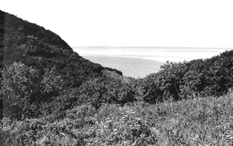Iyatayet Site facts for kids
|
Iyatayet Site
|
|

View of the site
|
|
| Location | Address restricted , Nome Census Area, Alaska, USA |
|---|---|
| Nearest city | Shaktoolik, Alaska |
| NRHP reference No. | 66000158 |
Quick facts for kids Significant dates |
|
| Added to NRHP | October 15, 1966 |
| Designated NHL | January 20, 1961 |
The Iyatayet Site is a very important archaeological site in Alaska. It's located on the northwest coast of Cape Denbigh, right on Norton Bay. This special place shows proof of different groups of people living there a very long time ago. Some evidence dates back as far as 6000 B.C., which is about 8,000 years ago!
Archaeologists started digging here in 1948. A famous archaeologist named J. Louis Giddings led these early explorations. The site is super important because it's the main example for understanding the Norton tradition. This was a culture of people who lived in the area from about 500 B.C. to 500 A.D. Giddings first described this culture in 1964.
Below the Norton culture layers, scientists found even older signs of human life. This older evidence is called the Cape Denbigh Flint Complex. It helps us learn about some of the very first people in this part of Alaska. Because of its historical importance, the Iyatayet Site was named a National Historic Landmark in 1961.
Exploring the Iyatayet Site
The Iyatayet Site sits on both sides of Iyatayet Creek. This creek flows into Norton Bay on the central-west coast of Alaska. Imagine digging down through layers of dirt, each layer telling a story about the past!
Layers of History
Archaeologists found many different layers of history at Iyatayet.
- Nukleet (Thule) People: The top layer showed signs of a settlement from the Nukleet (or Thule) tradition. You could see old house shapes in the ground.
- Norton Tradition: Below this, Giddings found an old house pit. This pit was dug into even older materials. Both the house pit and the older items became the main examples for the Norton tradition. This culture lasted from about 1000 B.C. to 800 A.D.
- Arctic Small Tool Tradition: The site also has some clues from the even older Arctic small tool tradition.
What They Found
Archaeologists found many interesting things at the site:
- Tools and Weapons: They discovered tools made from stone and ivory. These included spear points, harpoon heads for hunting seals, and stone knives.
- Decorative Items: A small ivory doll figure was also found, showing that people made art.
- Pottery: They found pieces of pottery. Most of these pots were simple and used for everyday tasks, not for decoration.
- Animal Bones: There weren't many animal bones left. But the tools suggest people hunted seals and fished. They also hunted caribou sometimes.
J. Louis Giddings' Work
J. Louis Giddings first studied the site in 1948. He called the oldest findings the "Denbigh Flint Complex." His detailed writings about the site were published in the 1960s. His work helped us understand how people lived in the Arctic thousands of years ago.

